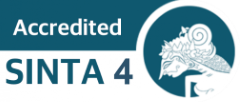Pengembangan Purwarupa Sistem Monitoring dan Proteksi Logam Menggunakan Metode Sacrificial Anode Cathodic Protection Berbasis Internet of Things (IoT)
DOI:
https://doi.org/10.31479/jtek.v11i1.275Abstract
AbstrakLogam adalah unsur yang sering digunakan pada industri maupun pada bidang konstruksi terutama logam besi. Namun, logam besi juga dapat mengalami korosi dan oksidasi ketika terkontaminasi oleh lingkungan yang mengandung oksigen. Oleh karena itu, diperlukan sistem monitoring dan proteksi korosi yang efektif untuk mencegah kerusakan pada logam besi. Metode yang digunakan untuk proteksi korosi pada logam adalah dengan Cathodic Protection. Cathodic Protection terdiri dari Impressed Current Cathodic Protection (ICCP) dan Sacrificial Anode Cathodic Protection (SACP). Metode ICCP melibatkan penggunaan arus listrik untuk mencegah korosi pada logam besi, sedangkan metode SACP melibatkan penggunaan logam yang lebih reaktif untuk melindungi logam besi dari korosi. Pada penelitian ini menggunakan metode SACP. Sistem ini terintegrasi IoT karena memiliki modul Wi-Fi. Data pengukuran berupa nilai tegangan pada logam dikirimkan ke platform ThingSpeak sehingga monitoring dapat dilakukan pada LCD, website, dan aplikasi android. Hasil penelitian yang telah dilakukan ini berhasil memproteksi logam besi yang terlindungi anoda dari logam zinc. Nilai tegangan logam besi terproteksi sebesar 1,04V pada air tawar. Diharapkan sistem ini dapat memberikan perlindungan yang efektif terhadap korosi pada logam besi. Kata kunci : Corrosion, ICCP, IoT, Iron, SACPDownloads
References
DAFTAR PUSTAKA
J. Sitompul, Y. P. Siahaan, M. B. Butar, J. C. Gulo and A. A. Bondar, "Pengaruh Total Hutang dan Perputaran Persediaan Terhadap Laba Bersih Pada Perusahaan Sub Sektor Industri Logam Yang Terdapat di Bursa Efek Indonesia," Jurnal Global Manajemen, vol. 11, no. 1, pp. 229-237, 2022.
F. Sidik, "Analisa Korosi dan Pengendaliannya," Jurnal Foundry, vol. 3, no. 1, pp. 25-30, 2013.
W. a. D.E, "Perhitungan Laju Korosi Untuk Menentukan Sisa Umur Pakai (Remaining Service Life) dan Sistem Perawatan Pada Jaringan Pipa Produksi Uap Geothermal di PT.Pertamina Geothermal Energy Area Kamojang," Bandung, Universitas Islam Bandung, 2016.
S. Sukarman, I. R. Sitorus, B. Aribowo, D. A. Rajab and Y. Heryadi, "Optimasi Parameter Proses Powder Coating Pada Plat Electro Galvanized," Prosiding SEMNASTERA, vol. 1, pp. 110-115, 2019.
Ahmadi and C. A. Dewi, "The Effect of Electric Flow on Decorative Krom Electroplating With Copper Base Metal Toward Corrosion Rate," PRISMA SAINS, vol. 1, no. 2, pp. 134 - 138, 2010.
B. Syahputra, S. J. Sisworo and A. Trimulyono, "Analisa Teknis & Ekonomis Perancangan Sistem Pencegahan Korosi Pada Lambung Kapal, Dengan Variasi Sistem Pencegahan Menggunakan ICCP (Impressed Current Cathodic Protection) Dibandingkan dengan SACP (Sacrificial Anode Cathodic Protection)," Jurnal Teknik Perkapalan, vol. 3, no. 2, pp. 247 - 253, 2015.
J. Oh, "The Performance of Cathodic Protection with ICCP," The Korean Society of Marine Engineers, vol. 28, no. 8, pp. 1286 - 1290, 2004.
D. A. Pratiwi, D. Rahmawati and F. Budiman, "Sistem Monitoring Perlindungan Logam Zn Menggunakan Metode ICCP Berbasis Internet of Things (IoT)," TREnD - Technology of Renewable Energy and Development, pp. 162-169, 2022.
I. Utami, "Proteksi Katodik Dengan Anoda Tumbal Sebagai Pengendalian Laju Korosi Baja Dalam Lingkungan Aqueous," Teknik Kimia , vol. 3, no. 2, pp. 240-245, 2009.
R. Indarti, Y. T. Sarungu and C. Magesang, "Karakterisasi Simulator Sistem Proteksi Katodik Metode Anoda Korban Pada Sistem Perpipaan Yang Tertanam Dalam Tanah," 9th Industrial Research Workshop and Nasional Seminar, vol. 9, pp. 41-45, 2018.
ThingSpeak, "Student License," ThingSpeak, [Online]. Available: https://thingspeak.com/prices/thingspeak_student
Downloads
Published
Issue
Section
License
The rights of publication and use of intellectual works in this journal are the full property of the publisher, while the moral rights belong to the author.
The formal legal aspects of access and utilization of each Journal of Technology articles are subjected to the Creative Commons Attribution-Share Alike (CC BY-SA) license, which means that journal content can be used freely and fairly (fair use) in a similar form even for commercial purposes.
To avoid malpractice and plagiarism in publication of article publishing, the author is asked to fill out and sign a copyright statement on the Declaration of Authenticity of the Manuscript and Copyright Transfer.






